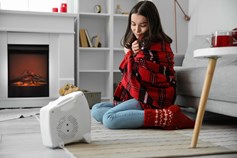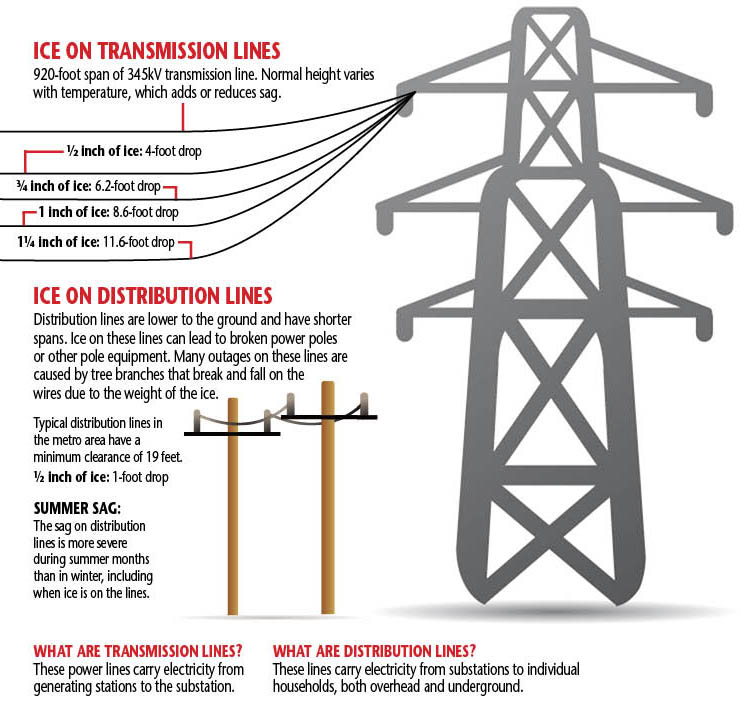
As our seasons shift toward colder weather and holiday celebrations, new electrical safety concerns can arise. OPPD wants to make sure you have all of the information you need to stay cozy and safe through the winter months, regardless of if you feel like you’re in a winter wonderland or a bleak, cold winter.
Help Us, Help You
The main thing to remember during the coldest part of the year is that conserving energy is key. We never know when the next blizzard, ice storm or polar vortex will hit, and OPPD asks customers to do their part to lessen the demand on the power grid during bad weather.
There are some simple things customers can do to keep from using excess energy this time of year:
- Unplug items that are not in use – they can still draw power, even when turned off.
- Open curtains and blinds – use the sun while it is shining on your house to help warm it.
- Change the direction of your ceiling fans - change the direction of ceiling fan rotation to clockwise in the winter. It will pull warm air up and around the room.
- Lower your thermostat a few degrees – each degree lower can reduce energy usage by 1-3%.
- Turn lights off when possible – even though it’s darker this time of year, remember to turn off lights in rooms you aren’t using and take advantage of the sun while it’s out.
 Learn More!
Learn More!
Tips to Boost Your Comfort This Winter
Space Heater Safety Tips
Ice Has Weighty Effect on Power Lines
Turning up the Heat - Safely
If you find certain rooms in your house a bit chilly, space heaters can be an excellent way to add some extra warmth. Plus, they are more energy efficient than turning up the thermostat. But make sure you’re smart when using space heaters in your home. Plug them directly into the wall outlet (not an extension cord or power strip), and don’t leave them running if no one is in the room - they can be fire hazards or cause burns. Make sure you choose a space heater with a guard around the heating element to keep children, pets and fabric away from the heat source. Buy a model that is designed for the space you want to heat, and make sure it has been tested and certified by a nationally recognized lab. Last but not least, make sure everyone in your home knows how to use the space heater properly.
The Weighty Effect of Ice on Power Lines
Winter weather provides a unique threat to power lines. When freezing rain or wet snowfall occurs, power lines start to sag – and it doesn’t take much ice to cause problems. As little as a half an inch of ice causes lines to drop around four feet. Over an inch of ice can cause a drop of over 11 feet. The extra weight and resulting sag can lead to broken lines or poles.
Ice can also cause “galloping” power lines. As ice accumulates on lines, it forms a teardrop shape which makes the line unbalanced and unsteady. Once the wind picks up, lines start swaying and moving erratically. OPPD customers can’t do anything to prevent the effects of weather on the power lines but be sure to stay alert and on the lookout for potential downed lines following a big winter storm. If you see a downed line following a storm, immediately call 911 or OPPD at 1-800-554-6773. And if you need to report a power outage, call 1-800-554-OPPD (6773), use the OPPDconect App (available for download on your smart phone or tablet), or fill out the Report Outage form on the OPPD website.

May Your Days be Merry and Bright – but Safe!
Outdoor Lights
When you’re decorating the outside of a home or building, make sure you are keeping an eye out for any nearby power lines – including the ones that lead into your house. If you’re lugging a ladder around, make sure to look up and know what you might run into. Make sure any lights you use have been approved by a testing laboratory and are certified for outdoor use. Newer lights offer thicker wiring and safety fuses that prevent overheating. So use extra caution if you’re stringing older lights, and consider replacing them. LED strands run cooler, reduce fire risks and use less electricity overall. And whether you use older lights or newer LED lights, never stick nails, staples or tacks through the wires!
Indoor Lights
Whether you’re trimming a tree or just adding a bright, festive touch to a room, make sure you inspect lights before you hang them. Frayed wires, gaps in the wire insulation, broken sockets and other damage can lead to several safety issues. If a string of lights is damaged – don’t use it! If you have old lights that need to be disposed of, look for holiday light recycling events nearby. Many businesses or boy scout troops will hold light recycling drives and some electronics recycling centers will accept old strings of lights.
When linking strings of lights together, stick to three or fewer. Unless specifically noted in the directions, more than three strings linked together can cause safety hazards. The most important electrical safety tip to remember year-round (not just when hanging holiday lights): Do not overload your outlets.
OPPD knows that winter can be a challenging time for some. As we all get ready to cozy up and enjoy the coming months, prepare to hibernate or simply make it through, we want all OPPD customers to be cognizant of safety when the weather outside is frightful. Check out the links in our Learn More! box and our other related articles and resources for additional information on winter weather and holiday safety.
Other Related Articles and Resources
Video: How to fix your holiday lights
How galloping power lines impact outages
Tips to keep your holidays merry, bright and safe

